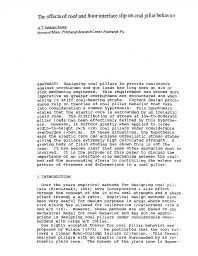Mining Publication: The Effects of Roof and Floor Interface Slip on Coal Pillar Behavior
Original creation date: January 1990
Designing coal pillars to provide resistance against overburden and gob loads has long been an aim of rock mechanics engineers. This requirement has become more imperative as greater overburdens are encountered and when mining in stiff coal-bearing strata. Current design procedures rely on theories of coal pillar behavior that take into consideration a common hypothesis. This hypothesis states that the elastic core is surrounded by an inelastic yield zone. The distribution of stress at low-to-moderate pillar loads has been effectively defined by this hypothesis. However, it suffers greatly when applied to large width-to-height (w/h >10) coal pillars under considerable overburden (>500 m). In these situations, the hypothesis says the elastic core can achieve unrealistic stress states, giving the pillars extremely high calculated strength. A growing body of field studies has shown this is not the case. It has become clear that some other mechanism must be involved. This U.S. Bureau of Mines paper discusses the importance of an interface slip mechanism between the coalbed and the surrounding strata in controlling the extent and pattern of stresses and deformations in a coal pillar.
Authors: AT Iannacchione
Conference Paper - January 1990
NIOSHTIC2 Number: 10008617
Rock Mechanics: Contributions and Challenges: Proceedings of the 31st U.S. Symposium, June 18-20, 1990, Colorado School of Mines, Golden, Colorado. Hustrulid WA, Johnson GA, ed., Brookfield, VT: A.A. Balkema, 1990 Jan; :153-160
See Also
- Assessment of Stable and Failed Pillars in Underground Limestone Mines
- Elastic and Shear Moduli of Coal Measure Rocks Derived from Basic Well Logs Using Fractal Statistics and Radial Basis Functions
- The Explosibility of Coal Dust
- The Ground Response Curve, Pillar Loading and Pillar Failure in Coal Mines
- MULSIM/NL Application and Practitioner's Manual
- Pillar Design Issues for Underground Stone Mines
- Pillar Mechanics of Coal Mine Bursts: A Control Strategy
- Proceedings: Mechanics and Mitigation of Violent Failure in Coal and Hard-Rock Mines
- Reservoir Rock Properties of Coal Measure Strata of the Lower Monongahela Group, Greene County (Southwestern Pennsylvania), from Methane Control and Production Perspectives
- The Unpredictable Life Cycle of a Coal Pillar
- Page last reviewed: 9/21/2012
- Page last updated: 9/21/2012
- Content source: National Institute for Occupational Safety and Health, Mining Program


 ShareCompartir
ShareCompartir
